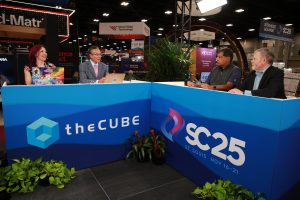 AI
AI
 AI
AI
 AI
AI
Artificial intelligence and supercomputing are accelerating scientific discovery.
This transformation is particularly visible in the partnership between National Energy Research Scientific Computing Center at the Lawrence Berkeley National Laboratory and Dell Technologies Inc., which has produced Doudna, a machine that enables complex scientific workflows with a ten times increase in performance.

NERSC’s Sudip Dosanjh and Dell’s Tony Rea discuss their collaboration.
“We have to take our vast user community, over 11,000 users, with us as we deploy every system,” said Sudip Dosanjh (pictured, left), scientific division director of NERSC. “It requires a close collaboration with Doudna, which we’re planning to deploy at the end of 2026. It really requires a great collaboration with Dell and with Nvidia because there are a lot of new capabilities.”
Dosanjh and Tony Rea (right), global AI infrastructure lead, Global Tech Office, at Dell, spoke with theCUBE’s Dave Vellante and Jackie McGuire at SC25, during an exclusive broadcast on theCUBE, SiliconANGLE Media’s livestreaming studio. They discussed how AI is shaping scientific discovery and the collaboration between NERSC and Dell. (* Disclosure below.)
NERSC has previously focused on modelling and simulation but now that scientists are experiencing a flood of data, the possibilities are opening up. The goal with Doudna is to harmonize large amounts of data, with an emphasis on orchestrating complex workflows, according to Rea.
“One of the things this machine’s going to be able to do is digest enormous amounts of data,” he said. “Part of the problem is that the instrumentation …and all these domains being used, the granularity and the resolution is going up and the amount of information is going up by an enormous amount every year.”
Doudna is a machine based on Nvidia’s Vera Rubin platform with Dell’s IR7000 rack, all of which is water-cooled for sustainability purposes. NERSC has started using dry chillers, which slightly decreases the energy efficiency but massively saves on water, which is especially important for the organization’s Northern California location.
As with most cutting edge technology these days, Doudna incorporates AI. The focus, according to Dosanjh, is on using machine analytics to analyze data in real time.
“It’s not just about AI,” he said. “It’s really about these very complex workflows that they want to run because they may want to transfer the data, run a simulation at the same time to help steer their experiment. They want feedback in real time. You have a telescope, you need to know pretty quickly when to refocus that telescope. If you have an experiment that’s running, you need to get information back fast enough for you to be able to make a change to your experiment.”
The collaboration between Dell and NERSC represents a shift in the industry. The pace of scientific discovery is accelerating, according to Dosangh and Rea, and AI and data analysis can contribute even more to that momentum.
“The barrier of entry to do scientific research is much lower now,” Rea said. “At NERSC … they’re doing a lot to enable the researchers to be more productive, to understand how to better use these machines.”
Here’s the complete video interview, part of SiliconANGLE’s and theCUBE’s coverage of SC25:
(* Disclosure: Dell Technologies Inc. sponsored this segment of theCUBE. Neither Dell nor other sponsors have editorial control over content on theCUBE or SiliconANGLE.)
Support our mission to keep content open and free by engaging with theCUBE community. Join theCUBE’s Alumni Trust Network, where technology leaders connect, share intelligence and create opportunities.
Founded by tech visionaries John Furrier and Dave Vellante, SiliconANGLE Media has built a dynamic ecosystem of industry-leading digital media brands that reach 15+ million elite tech professionals. Our new proprietary theCUBE AI Video Cloud is breaking ground in audience interaction, leveraging theCUBEai.com neural network to help technology companies make data-driven decisions and stay at the forefront of industry conversations.